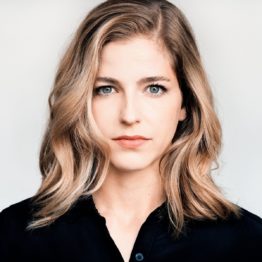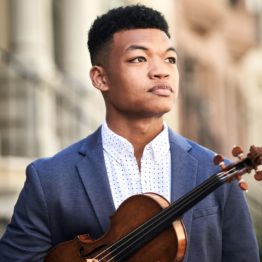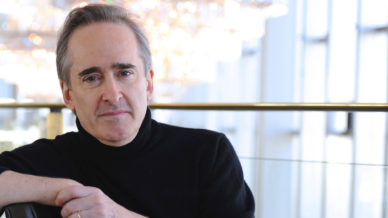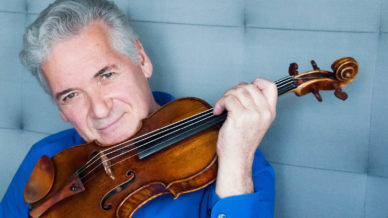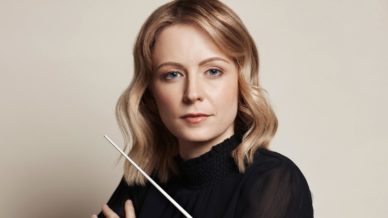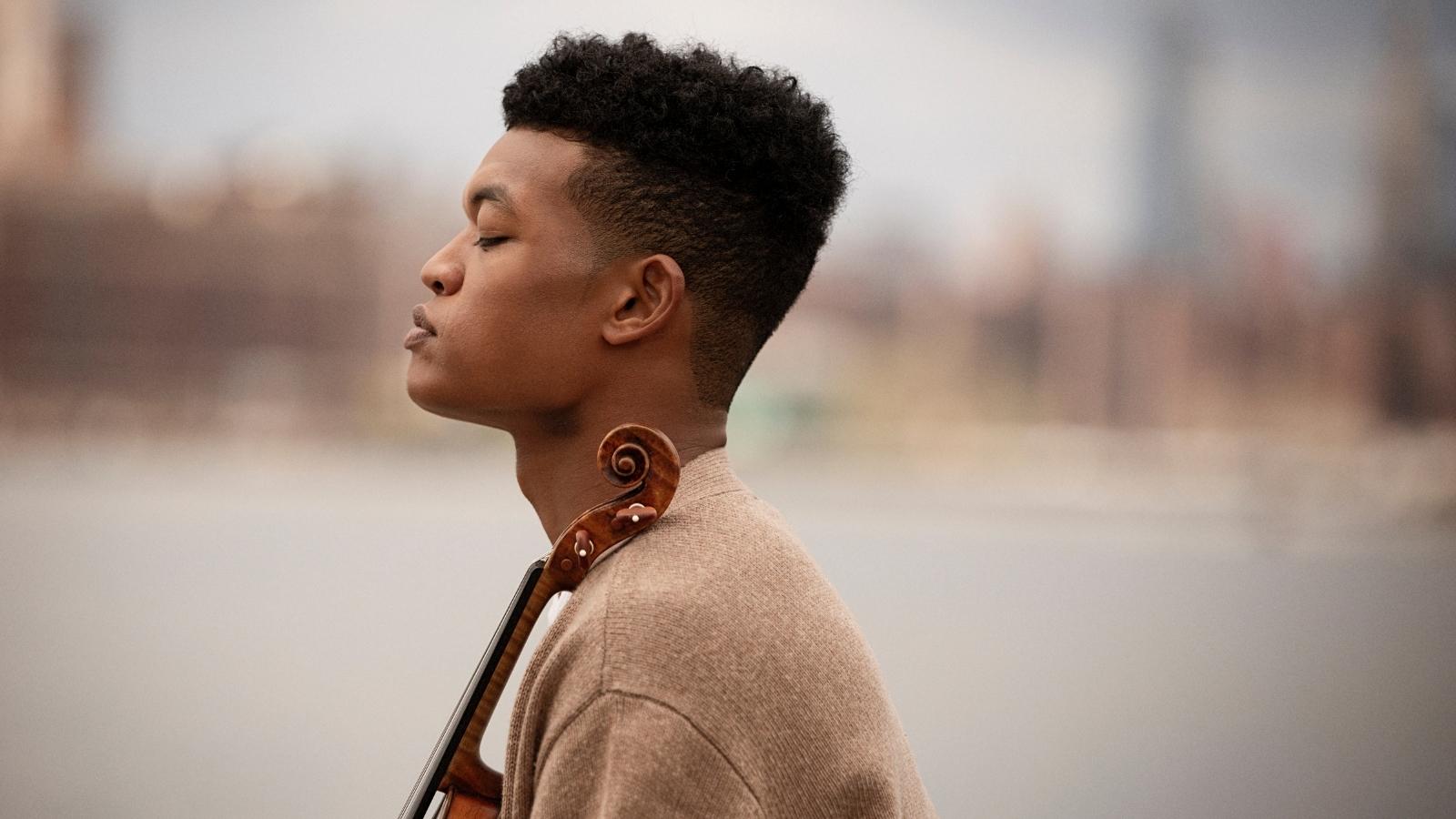

Tchaikovsky Violin Concerto
January 27 – 29, 2023
KARINA CANELLAKIS conducts
RANDALL GOOSBY violin
DVOŘÁK The Wood Dove
TCHAIKOVSKY Concerto in D Major for Violin and Orchestra
LUTOSŁAWSKI Concerto for Orchestra
Internationally acclaimed for her emotionally charged performances, technical command and interpretive depth, Karina Canellakis returns to the Meyerson stage to bring us Dvořák’s orchestral poem, The Wood Dove, a dark poem focused on a woman who poisoned her husband to marry another man. Over four musical scenes, Dvořák describes a story where a woman poisons her husband and marries another man. And then, day after day, a dove sits on the dead husband’s grave singing a sad song, evoking so much guilt that the wife in the story jumps into a river and drowns. This story comes from the poem of the same name from Kytice, a collection of ballads by Karel Jaromír Erben.
Also on the program, Randall Goosby, the fast-rising 27-year-old star and Decca recording Roots violinist, who joins the Dallas Symphony to perform Tchaikovsky’s Concerto in D Major, his only concerto for violin, written in 1878 by the shores of Lake Geneva, is one of the best-known violin concertos of all time!
To close, Lutosławski’s Concerto for Orchestra highlights the DSO musicians with thrilling and elaborate orchestral textures.

Program Notes
by René Spencer Saller
In the last decade of his life, Dvořák was internationally famous and financially secure, free to compose whatever he liked. He wrote his most famous symphony (the Ninth, nicknamed “From the New World”) in 1893, along with the celebrated String Quartet in F (“American”) while he was employed in the United States as the highly paid director of an ambitious new conservatory founded by the New York philanthropist Jeannette Thurber. After returning to his beloved Bohemia in 1895, the homesick composer immersed himself in the folk culture of his homeland, which inspired him to compose the fairy-tale opera Rusalka (1901) and the four symphonic poems culminating in The Wood Dove.
Dvořák composed The Wood Dove (Holoubek in Czech, and sometimes translated as The Wild Dove) in October and November 1896, revising it in January 1897. It’s the fourth in a set of four symphonic poems based on tales from Kytice (Bouquet), a collection of gorgeously grim folk ballads by his fellow Bohemian Karel Jaromír Erben (1811–1870). Dvořák completed the preceding three symphonic poems—”The Water Goblin,” “The Noon Witch,” and “The Golden Spinning Wheel”—in a burst of productivity in early 1896, but he let several months elapse before beginning work on the last of the Erben-inspired symphonic poems.
The Wood Dove, the most formally compact of the set, dramatizes Erben’s fable in four musical vignettes that precisely correspond to the plot. A woman poisons her husband and feigns grief at his funeral. She becomes infatuated with a younger man, a cheerful rustic, and they flirt and frolic, climaxing in a festive country wedding. But then a dove shows up on her first husband’s grave, stolidly singing the same sad song. Ultimately, the widowed bride is so overcome by remorse that she drowns herself in the river. Although Erben’s story ends on this tragic note, Dvořák’s musical rendition appends a hopeful coda, perhaps hinting at some form of future redemption.
The world premiere took place in Brno, in what is now the Czech Republic, on March 20, 1898, under the baton of Czech composer Leoš Janáček, a late-blooming genius who had only recently begun to attract positive notice. The Austrian composer and conductor Gustav Mahler, then at the peak of his career, led the Vienna Philharmonic in the second performance on December 3, 1899. Dvořák conducted The Wood Dove himself only once, in Prague on April 4, 1900. This would turn out to be his last public appearance as a conductor.
A Closer Listen
Cast in C minor and marked Marcia funebre (funeral march), the opening Andante is slow and sepulchral. Cymbal and drum mark the mournful solemnity of the occasion as a seven-note theme based on a rising-and-falling scalar fragment makes the first of many appearances. Dvořák called this the “curse motif,” and it undergirds the whole composition, supporting all further thematic material. (For this reason The Wood Dove is often described as monothematic, or single-themed.) The mood shifts according to the instrumentation and harmonies, but the “curse” persists.
A molto vivace passage leads to a love duet, representing the brief courtship and wedding of the murderous widow and the young man. The festivities end abruptly when Dvořák conjures up the judgmental wood dove, who sings incessantly of the bride’s great sin (“The unhappy themselves find their graves,” as Erben put it.) Dvořák simulates the dove’s soulful cooing with two flutes, harp, and oboe.
In the ensuing Andante, the guilt-stricken woman, voiced by a solo violin, drowns herself after expressing how relieved she felt to confess her crime. Dvořák circles back to the opening theme and a reprise of the funeral march—now dedicated to the culprit turned victim. Dvořák shifts to the major key for his epilogue, suggesting that even if the curse can’t be lifted, it might still be lightened.
Tchaikovsky composed only one Violin Concerto, and it wasn’t an immediate hit. Repelled by its dissonance and difficulty, two violinists refused to debut it. After its eventual premiere, the prominent critic Eduard Hanslick complained that “the violin was not played but beaten black and blue” and that the music “stinks to the ear.” Tchaikovsky was stung by the blistering review and never forgot it. Yet today the Violin Concerto ranks among the most beloved examples of the genre. Its highly hummable themes have graced countless pop-culture artifacts, from a cult-classic Monty Python album to the pilot episode of Mozart in the Jungle.
Although Tchaikovsky composed his Violin Concert in a matter of weeks, it came in the wake of a serious emotional crisis. On June 1, 1877, about nine months before he began writing it, the 37-year-old composer visited Antonina Milyukova for the first time. A student at the Moscow Conservatory, where Tchaikovsky had been teaching for the past decade, Milyukova had been sending him letters threatening suicide if he rejected her. Despite (or likely because of) his homosexuality, he proposed two days after their initial meeting, and they married that July. Two months later, he tried to kill himself by wading out into the ice-clogged Moscow River.
With help from his younger brother and a St. Petersburg psychiatrist, Tchaikovsky freed himself from the disastrous marriage. Some months later, while traveling throughout Europe, he received the life-changing news that Nadezdha von Meck, his generous new patron, was planning to send him an annual stipend that would allow him to resign from the Conservatory. For the next 14 years, Tchaikovsky and the wealthy widow exchanged hundreds of remarkably intimate letters without ever meeting in person.
In March 1878, while visiting Clarens, Switzerland, with his former student (and rumored lover) the violinist Yosif Kotek, Tchaikovsky was, in his words, “seized… with a burning inspiration.” In just five days, he finished the first movement of the concerto; he dashed off the second and third about a week later. After playing through it with Kotek, he decided to substitute a new Andante, one “better suited to the other two movements.” In less than a month, the score was complete. In late April he returned to Russia and eventually persuaded Milyukova to grant him a divorce.
Unfortunately, the road ahead was rockier. Both Kotek and the famous violinist Leopold Auer—Tchaikovsky’s first choice for dedicatee—declined to debut the concerto, objecting to its copious double stops, glissandi, leaps, trills, and dissonances. The premiere was postponed until December 4, 1881, when Adolf Brodsky performed it with the Vienna Philharmonic. Despite some exceptionally harsh early reviews, it eventually won favor, even from Auer, who taught it to his students, including the legendary Jascha Heifetz.
A Closer Listen
At the opening of the Allegro moderato, Tchaikovsky teases us with a catchy lilting tune sung by the violins. It quickly morphs into a new, more suspenseful idea, which paves the way for the soloist’s entrance. Lyrical and expressive at first, the solo violin gradually becomes more virtuosic and syncopated. A fiery cadenza follows the dancelike development section, and the movement concludes with a glittering recapitulation.
The second and third movements are played attaca (without pause). Set in the unexpected key of G minor, the Canzonetta (Italian for “little ballad”) starts with a solemn theme voiced by the woodwinds. The solo violin introduces a deliciously dissonant melody, reminiscent of a Russian folk dance. The driving, fiendishly difficult finale, marked Allegro vivacissimo, returns to the home key of D major for even more Slavic pyrotechnics.
The foremost Polish composer of his generation, Lutosławski was born in Warsaw, in 1913, when it was still a province of Imperial Russia. When he was five years old, his father, a member of the landed gentry, was executed by the Bolsheviks. Despite the ongoing political unrest, Lutosławski, who had shown early promise as a pianist and violinist, earned degrees from the Warsaw Conservatory in piano and composition. In the summer of 1939, he was sent to war as an officer cadet. He was captured by the Germans, but he quickly escaped and returned to Warsaw, where he cobbled together a living playing piano in cafés.
In 1941 he wrote his first significant piece, the Variations on a Theme by Paganini for two pianos. Few of his other early works survived the destruction of Warsaw during the final year of World War II. In 1947, while working as the music director of Polish Radio, he completed his boldly atonal Symphony No. 1, but when the Communists assumed power in 1948, the symphony was banned and he was labeled a “formalist”—a dangerous designation that could easily bring on a death sentence. In accordance with the dictates of state-sanctioned social realism, Lutosławski began to incorporate folk elements in his work, although he remained committed to exploring new harmonic and structural possibilities. “I wrote as I was able,” he later explained, “since I could not yet write as I wished.”
Composed over four years and completed in 1954, Lutosławski’s Concerto for Orchestra was an immediate hit, securing his position as a formidable figure in contemporary music. He later downplayed his use of folk melodies, calling them merely “raw material” for his “episodic symbiosis with folk music.” Today the Concerto for Orchestra ranks among his most frequently performed and recorded compositions, thanks to its vast dynamic range, its arresting orchestral textures, and its bold reinventions of ancient forms, such as the passacaglia.
The word passacaglia derives from the Spanish words passar and calle, loosely translated as “to walk the street.” Eventually the term was used to describe an orchestral genre in which a series of variations develop over a steady harmonic progression, typically occupying eight bars in 3/4 or 3/2 time.
A Closer Listen
The opening Intrada assembles motifs from Masovian folk songs into an intricately contrapuntal mosaic.
The central movement, Capriccio notturno ed Arioso, is a dramatic scherzo that scampers nimbly between whimsy and nightmare, closing not with a bang but a whisper of tenor and bass drums.
The finale, an ambitious synthesis, is more than twice as long as the two preceding movements combined. It begins quietly, with harp and double basses, before introducing the theme for a passacaglia that generates 15 linked variations. Next, a sturdy, cheerful toccata leads to a somber, Bartók-inflected chorale voiced by the woodwinds. The concerto ends on a high note as the entire orchestra explodes in an exultant coda.
